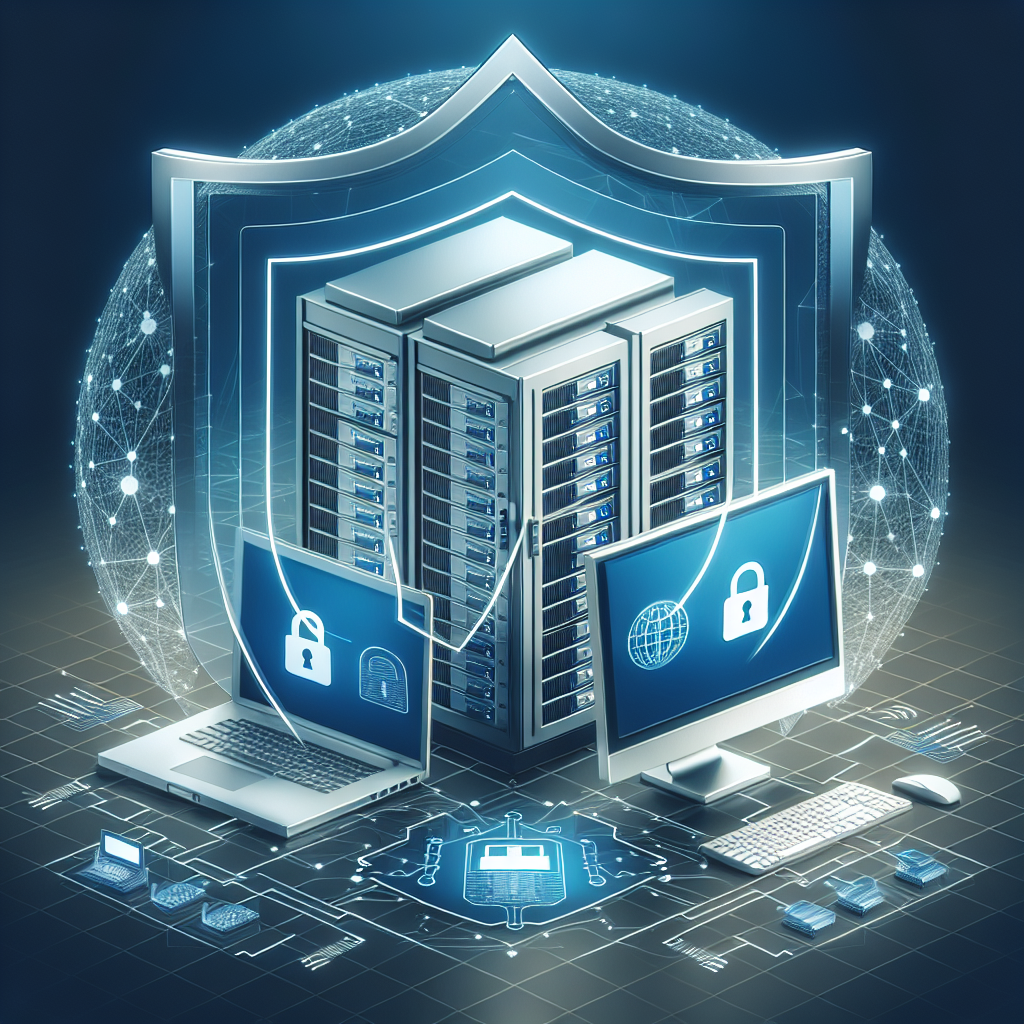Your cart is currently empty!
Tag: Solutions

The Future of IT Solutions: Trends to Watch in 2021
The world of Information Technology (IT) is constantly evolving, with new trends and technologies emerging every year. As we look forward to 2021, it’s important to stay ahead of the curve and keep an eye on the latest developments in IT solutions. Here are some key trends to watch in the coming year:1. Artificial Intelligence (AI) and Machine Learning: AI and machine learning are already revolutionizing the way businesses operate, and this trend is set to continue in 2021. From predictive analytics to automated customer service, AI-driven solutions are becoming increasingly prevalent in various industries.
2. Internet of Things (IoT): The IoT is expanding rapidly, with more devices connected to the internet than ever before. In 2021, we can expect to see even more IoT solutions being integrated into everyday life, from smart homes to connected cars.
3. Cybersecurity: With the rise of cyber threats and data breaches, cybersecurity remains a top priority for businesses in 2021. IT solutions that focus on protecting sensitive information and preventing cyber attacks will be in high demand.
4. Cloud Computing: Cloud computing has become the backbone of IT infrastructure for many organizations, providing scalability, flexibility, and cost savings. In 2021, we can expect to see further advancements in cloud technology, such as multi-cloud solutions and edge computing.
5. Remote Work Solutions: The COVID-19 pandemic has accelerated the shift towards remote work, leading to an increased demand for IT solutions that enable employees to work from anywhere. In 2021, we can expect to see more tools and technologies designed to support remote collaboration and communication.
6. Blockchain: Blockchain technology is gaining traction in various industries, from finance to healthcare. In 2021, we can expect to see more IT solutions leveraging blockchain for secure transactions, supply chain management, and data verification.
7. 5G Technology: The rollout of 5G technology will bring faster speeds and lower latency, opening up new possibilities for IT solutions in areas such as augmented reality, virtual reality, and autonomous vehicles. In 2021, we can expect to see more innovations that take advantage of 5G connectivity.
Overall, the future of IT solutions in 2021 looks bright, with exciting developments in AI, IoT, cybersecurity, cloud computing, remote work, blockchain, and 5G technology. By staying informed and embracing these trends, businesses can stay competitive and drive innovation in the digital age.

The Evolution of Managed Service Providers: From Break-Fix to Proactive IT Solutions
Managed Service Providers (MSPs) have come a long way since the early days of break-fix IT support. In the past, businesses would only call on IT support when something went wrong, resulting in costly downtime and lost productivity. However, as technology has evolved, so too have the services offered by MSPs.The shift from break-fix to proactive IT solutions has been driven by the increasing complexity of technology and the need for businesses to stay ahead of the curve. MSPs now offer a range of services designed to prevent issues before they occur, such as network monitoring, security audits, and regular software updates.
One of the key benefits of proactive IT solutions is the ability to predict and prevent problems before they impact the business. This not only reduces downtime and IT costs but also allows businesses to focus on their core operations without worrying about technical issues.
Another significant evolution in the MSP industry is the move towards cloud-based solutions. Cloud computing offers businesses greater flexibility, scalability, and cost-efficiency compared to traditional on-premise IT infrastructure. MSPs now offer a range of cloud services, including cloud storage, backup, and disaster recovery, to help businesses leverage the power of the cloud.
Furthermore, the rise of remote work has also shaped the services offered by MSPs. With more employees working from home, businesses need secure and reliable IT solutions to support their remote workforce. MSPs now offer remote monitoring and management services, as well as cybersecurity solutions to protect sensitive data from cyber threats.
Overall, the evolution of Managed Service Providers from break-fix to proactive IT solutions has been driven by the changing needs of businesses and advancements in technology. By partnering with an MSP, businesses can benefit from a range of services designed to keep their IT systems running smoothly and securely, allowing them to focus on their core operations and drive growth.

Top Data Backup Solutions for Small Businesses
In today’s digital age, data is one of the most valuable assets for businesses of all sizes. However, small businesses often overlook the importance of data backup and recovery until it’s too late. Data loss can be devastating for a small business, leading to lost revenue, damaged reputation, and even closure. That’s why it’s crucial for small businesses to invest in reliable data backup solutions to protect their valuable information.Here are some of the top data backup solutions for small businesses:
1. Cloud Backup Services: Cloud backup services offer a convenient and cost-effective solution for small businesses to backup their data securely. With cloud backup, data is stored offsite in secure data centers, protecting it from physical disasters such as fires or floods. Cloud backup services also provide automatic backups, so you don’t have to worry about remembering to back up your data regularly.
2. External Hard Drives: External hard drives are a simple and affordable data backup solution for small businesses. You can manually back up your data to an external hard drive on a regular basis, or use software that automatically backs up your data at scheduled intervals. External hard drives are portable and easy to use, making them a popular choice for small businesses with limited IT resources.
3. Network Attached Storage (NAS): NAS devices are another popular data backup solution for small businesses. NAS devices connect to your network and provide a centralized storage solution for backing up data from multiple devices. NAS devices offer features such as RAID (Redundant Array of Independent Disks) for data redundancy and protection against drive failures.
4. Backup Software: Backup software is a crucial component of any data backup strategy. Backup software automates the backup process, making it easy to schedule regular backups and restore data quickly in the event of a data loss. Many backup software solutions offer features such as encryption, compression, and deduplication to optimize storage space and protect sensitive data.
5. Hybrid Backup Solutions: Hybrid backup solutions combine the benefits of on-premises and cloud backup to provide a comprehensive data protection strategy. With hybrid backup, you can backup your data locally to a NAS device or external hard drive, and also replicate your data to the cloud for offsite protection. Hybrid backup solutions offer the flexibility and scalability to meet the data backup needs of small businesses.
In conclusion, data backup is a critical component of a small business’s IT strategy. Investing in reliable data backup solutions can help protect your business from the devastating consequences of data loss. Whether you choose cloud backup services, external hard drives, NAS devices, backup software, or hybrid backup solutions, it’s essential to have a data backup plan in place to safeguard your valuable information. Don’t wait until it’s too late – start backing up your data today!

Top 10 IT Solutions for Streamlining Your Business Operations
In today’s fast-paced business world, it’s essential for companies to stay ahead of the curve when it comes to technology. With the right IT solutions in place, businesses can streamline their operations, increase productivity, and ultimately drive growth. Here are the top 10 IT solutions that can help streamline your business operations:1. Cloud Computing: Cloud computing allows businesses to store and access their data and applications over the internet, eliminating the need for physical servers and hardware. This can greatly reduce costs and improve flexibility and scalability.
2. Business Process Automation: Using software to automate repetitive tasks and workflows can save time and improve efficiency. From email marketing to customer service, there are numerous tools available to streamline business processes.
3. Customer Relationship Management (CRM) Software: CRM software helps businesses manage relationships with customers and track sales and marketing activities. By centralizing customer data, businesses can improve customer service and increase sales.
4. Enterprise Resource Planning (ERP) Systems: ERP systems integrate various business functions, such as finance, inventory, and human resources, into one centralized platform. This can streamline operations and improve communication between departments.
5. Project Management Tools: Project management tools help businesses plan, organize, and track projects and tasks. This can improve collaboration among team members and ensure projects are completed on time and within budget.
6. Cybersecurity Solutions: With the increasing threat of cyber attacks, it’s essential for businesses to invest in cybersecurity solutions to protect their data and systems. This can include firewalls, encryption, and security monitoring tools.
7. Mobile Apps: Mobile apps can help businesses connect with customers and employees on the go. From mobile payment options to employee scheduling tools, there are numerous ways mobile apps can streamline business operations.
8. Data Analytics Tools: Data analytics tools help businesses analyze their data to make informed decisions and identify trends and patterns. This can improve business performance and drive growth.
9. Communication and Collaboration Tools: Communication and collaboration tools, such as video conferencing and instant messaging platforms, help businesses connect with employees and clients regardless of location. This can improve communication and productivity.
10. Internet of Things (IoT) Devices: IoT devices, such as smart sensors and connected devices, can collect and exchange data to improve business operations. From inventory management to predictive maintenance, IoT devices can streamline various aspects of a business.
In conclusion, investing in the right IT solutions can help businesses streamline their operations, improve efficiency, and ultimately drive growth. By staying up to date with the latest technology trends and implementing the right tools, businesses can stay ahead of the competition and achieve success in today’s digital age.

Maximizing Efficiency with Managed Service Provider Solutions
In today’s fast-paced business world, companies are constantly looking for ways to increase efficiency and productivity. One way to achieve this is by utilizing managed service provider solutions. Managed service providers (MSPs) offer a range of services that can help businesses streamline their operations and free up valuable resources.One of the key benefits of working with an MSP is the ability to outsource IT tasks and responsibilities. Many businesses struggle to keep up with the rapidly changing technology landscape, and managing IT infrastructure can be a daunting task. By partnering with an MSP, companies can offload the day-to-day management of their IT systems, allowing them to focus on core business activities.
Managed service providers also offer proactive monitoring and maintenance services, which can help prevent costly downtime and ensure that systems are running smoothly. This can help businesses avoid the headaches and financial losses associated with unexpected IT issues.
Another advantage of working with an MSP is access to a team of highly skilled professionals. MSPs typically employ experts in various technology areas, including networking, cybersecurity, and cloud computing. This means that businesses can benefit from the expertise of these specialists without having to hire and train in-house staff.
Additionally, MSPs can offer cost-effective solutions that can help businesses save money in the long run. By leveraging the economies of scale that come with managing multiple clients, MSPs can often provide services at a lower cost than businesses would incur if they were to manage their IT systems internally.
Overall, working with a managed service provider can help businesses maximize efficiency in several ways. By outsourcing IT tasks, businesses can focus on their core activities, while benefiting from proactive monitoring and maintenance services, access to a team of experts, and cost-effective solutions. In today’s competitive business environment, partnering with an MSP can give companies a competitive edge and help them stay ahead of the curve.

Streamlining Operations with Integrated IT Solutions
In today’s fast-paced business environment, efficiency is key to staying competitive. Streamlining operations is essential for maximizing productivity and profitability. One way to achieve this is by implementing integrated IT solutions that bring together various systems and processes into a cohesive and seamless workflow.Integrated IT solutions combine different technologies and tools to create a centralized platform that connects various departments and functions within an organization. This allows for real-time data sharing, automated processes, and improved communication among team members. By streamlining operations through integrated IT solutions, businesses can eliminate manual tasks, reduce errors, and increase operational efficiency.
One of the key benefits of integrated IT solutions is improved collaboration among employees. With a centralized platform, team members can easily access and share information, collaborate on projects, and communicate in real-time. This streamlines communication and decision-making processes, leading to faster project completion and more efficient workflows.
Another advantage of integrated IT solutions is the ability to automate repetitive tasks. By integrating different systems and processes, businesses can automate routine tasks such as data entry, invoicing, and reporting. This not only saves time and reduces errors but also allows employees to focus on more strategic tasks that add value to the business.
Additionally, integrated IT solutions provide better visibility into business operations. By consolidating data from various systems and sources, businesses can gain a comprehensive view of their operations and performance. This allows for better decision-making, improved forecasting, and more informed strategic planning.
Overall, streamlining operations with integrated IT solutions can help businesses achieve greater efficiency, productivity, and profitability. By connecting various systems and processes into a centralized platform, businesses can improve collaboration, automate tasks, and gain better visibility into their operations. As technology continues to evolve, integrated IT solutions will play an increasingly important role in helping businesses stay competitive and adapt to the changing business landscape.

Cybersecurity Essentials: Protecting Your Business with IT Solutions
In today’s digital age, cybersecurity has become a crucial aspect of running a successful business. With cyber threats constantly evolving and becoming more sophisticated, it is essential for companies to prioritize their cybersecurity measures in order to protect their sensitive data and information. This is where IT solutions come into play, providing businesses with the tools and technologies needed to safeguard their systems and networks from potential cyber attacks.One of the key cybersecurity essentials for businesses is endpoint security. Endpoint security refers to the protection of network endpoints, such as laptops, smartphones, and other devices, from malicious cyber threats. This is especially important for businesses that have employees working remotely or using their own devices for work purposes. By implementing endpoint security solutions, businesses can ensure that all devices connected to their network are secure and protected from cyber attacks.
Another essential aspect of cybersecurity for businesses is network security. Network security involves the implementation of various technologies and processes to protect a company’s network infrastructure from unauthorized access, data breaches, and other cyber threats. This includes firewalls, intrusion detection systems, and virtual private networks (VPNs) to create a secure network environment for businesses to operate in.
In addition to endpoint and network security, businesses should also consider implementing strong access control measures to protect their sensitive data. Access control involves restricting access to certain areas of a network or specific information to authorized individuals only. This can be achieved through the use of passwords, biometric authentication, and multi-factor authentication to ensure that only authorized users have access to sensitive data.
Furthermore, businesses should regularly update their software and systems to patch any vulnerabilities that may be exploited by cyber attackers. This includes installing security updates and patches for operating systems, applications, and other software to prevent cyber attacks and data breaches.
Overall, cybersecurity is a critical component of running a successful business in today’s digital landscape. By implementing IT solutions such as endpoint security, network security, access control, and regular software updates, businesses can protect their sensitive data and information from cyber threats and ensure the security of their systems and networks.
In conclusion, cybersecurity essentials are crucial for protecting your business from cyber threats and data breaches. By investing in IT solutions and implementing strong cybersecurity measures, businesses can safeguard their sensitive data and information and maintain the trust of their customers and clients. Remember, it’s better to be proactive and prevent cyber attacks than to deal with the aftermath of a data breach.

Beyond Backup: Comprehensive Disaster Recovery Solutions for Today’s Businesses
In today’s fast-paced and technology-driven world, businesses rely heavily on their data and systems to operate efficiently. However, with the increasing threat of cyber attacks, natural disasters, and human error, the need for comprehensive disaster recovery solutions has never been greater.Beyond backup solutions offer businesses a more robust and holistic approach to protecting their data and systems. While traditional backup solutions simply copy and store data, disaster recovery solutions go a step further by providing a comprehensive plan for restoring systems and operations in the event of a disaster.
One key component of beyond backup solutions is the ability to quickly recover data and systems in the event of a catastrophic event. This includes having redundant copies of data stored in multiple locations, as well as the ability to quickly restore systems and applications to minimize downtime.
Another important feature of disaster recovery solutions is the ability to test and validate the recovery plan on a regular basis. This ensures that the plan is up to date and can be effectively executed when needed.
Beyond backup solutions also offer businesses the flexibility to choose the level of protection that best suits their needs. This could include options such as cloud-based disaster recovery, data replication, and virtualization, among others.
In addition to protecting data and systems, beyond backup solutions can also help businesses comply with industry regulations and standards. By ensuring that data is securely stored and easily recoverable, businesses can avoid costly fines and penalties for non-compliance.
Overall, beyond backup solutions provide businesses with a comprehensive and proactive approach to disaster recovery. By investing in these solutions, businesses can minimize the impact of disasters and ensure that their operations remain secure and operational in any situation.

Maximizing Efficiency with IT Solutions
In today’s fast-paced and competitive business environment, efficiency is key to staying ahead of the game. One of the most effective ways to maximize efficiency in your organization is by implementing IT solutions that streamline processes, automate tasks, and improve overall productivity.IT solutions encompass a wide range of technologies and systems that are designed to help businesses operate more efficiently and effectively. From cloud computing and data analytics to customer relationship management (CRM) software and project management tools, there are countless IT solutions available to help companies optimize their operations.
One of the most popular IT solutions for maximizing efficiency is cloud computing. By storing data and applications in the cloud, businesses can access information from anywhere at any time, allowing for greater flexibility and collaboration among team members. Cloud computing also reduces the need for physical storage space and can lower IT costs in the long run.
Data analytics is another powerful IT solution that can help businesses make more informed decisions and improve overall efficiency. By analyzing large volumes of data, companies can uncover valuable insights and trends that can drive strategic decision-making and improve business processes. Data analytics can also help organizations identify areas for improvement and optimize performance across various departments.
CRM software is another essential IT solution for maximizing efficiency. By centralizing customer data and streamlining communication with clients, CRM software can help businesses better understand their customers’ needs and preferences, resulting in improved customer satisfaction and retention. CRM software also helps organizations track sales leads, manage marketing campaigns, and automate routine tasks, saving time and resources in the process.
Project management tools are also key IT solutions for maximizing efficiency in organizations. By providing a centralized platform for planning, tracking, and monitoring projects, project management tools help teams stay organized and on track to meet deadlines and deliverables. These tools also enable effective collaboration among team members, leading to increased productivity and better project outcomes.
In conclusion, IT solutions play a crucial role in maximizing efficiency in today’s business world. By leveraging technologies such as cloud computing, data analytics, CRM software, and project management tools, organizations can streamline processes, automate tasks, and improve overall productivity. Investing in IT solutions is a smart decision for businesses looking to stay competitive and achieve long-term success in today’s digital age.

Implementing Cloud-Based IT Solutions: A Step-by-Step Guide
Cloud-based IT solutions have become increasingly popular in recent years due to their flexibility, scalability, and cost-effectiveness. Implementing these solutions can help organizations streamline their operations, improve collaboration, and enhance overall efficiency. However, the process of implementing cloud-based IT solutions can be complex and daunting for many organizations. In this article, we will provide a step-by-step guide to help you successfully implement cloud-based IT solutions in your organization.Step 1: Define your goals and requirements
Before you begin implementing cloud-based IT solutions, it is important to clearly define your goals and requirements. Identify the specific challenges and pain points that your organization is facing, and determine how cloud-based IT solutions can help address these issues. Consider factors such as scalability, security, compliance, and integration with existing systems.
Step 2: Choose the right cloud provider
Once you have a clear understanding of your goals and requirements, the next step is to choose the right cloud provider. There are several cloud providers in the market, each offering different features and pricing options. Consider factors such as the provider’s reputation, service level agreements, data security measures, and customer support when selecting a cloud provider.
Step 3: Plan your migration strategy
Before migrating your data and applications to the cloud, it is important to develop a comprehensive migration strategy. This strategy should outline the steps involved in the migration process, including data transfer, application reconfiguration, and testing. Consider conducting a pilot migration to identify any potential issues and ensure a smooth transition to the cloud.
Step 4: Train your team
Implementing cloud-based IT solutions will require your team to learn new technologies and processes. Provide comprehensive training to your team to ensure they have the necessary skills and knowledge to effectively use and manage cloud-based IT solutions. Consider offering training sessions, workshops, and online resources to support your team throughout the implementation process.
Step 5: Monitor and optimize
Once you have implemented cloud-based IT solutions, it is important to continuously monitor and optimize your cloud environment. Monitor performance metrics, security incidents, and costs to identify any areas for improvement. Consider implementing automation tools and best practices to optimize your cloud environment and ensure optimal performance.
In conclusion, implementing cloud-based IT solutions can help organizations improve efficiency, reduce costs, and enhance collaboration. By following these steps, you can successfully implement cloud-based IT solutions in your organization and reap the benefits of cloud technology. Remember to define your goals and requirements, choose the right cloud provider, plan your migration strategy, train your team, and continuously monitor and optimize your cloud environment.
